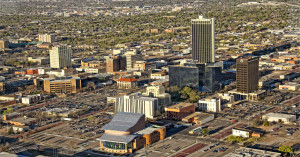Amarillo City Councilman Mark Nair is a bright young man who speak at times in somewhat academic terms about public policy.
For example, I have heard the City Council freshman use the term “organic growth” to describe how he’d like to see downtown Amarillo grow.
I’m not sure how one defines “organic growth” as it pertains to commercial development. But here’s what I’ve witnessed in the city’s downtown business district since my wife and I moved here more than 20 years ago.
- The transition of the historic Fisk building into a business hotel.
- The development of several bank plazas: Happy State Bank and Wells Fargo come to mind.
- The revitalization of the Potter County Courthouse Square.
- Expansion and improvements at several downtown-area churches.
- A new convenience store.
- Development of the Eagle Center into downtown residences.
- Several new nightspots and nice lunchtime eating establishments along Polk Street.
- Returning the Paramount Building neon sign and the occupancy of the old structure.
- Complete renovation and restoration of the Santa Fe Building for use by several Potter County offices.
- Construction of a state-of-the-art entertainment center across the street from the Civic Center.
- A higher education institution, which is moving soon from the Chase Tower to a new location in the downtown business district.
I no doubt have missed something. My point is that downtown Amarillo is in much better condition today than it was when my wife and I landed here in early 1995.
The vast majority of that improvement has been done with private money. The state kicked in historic preservation grant money to re-do the exterior of the county courthouse and the Santa Fe Building; Potter County issued certificate of obligation to do the rest.
The city has kicked in some public money for infrastructure improvements, such as sidewalks and curb cuts at street corners.
Xcel Energy has begun construction of a new office complex. Ground has been broken on a new convention hotel.
A multipurpose event venue — which Councilman Nair and others on the council apparently oppose — might be built next to City Hall. Then again, it might not … depending on how much foot-dragging and delay tactics occur at the City Council and Local Government Corp. level.
Organic growth?
It seems to this layman’s eyes that downtown has grown pretty organically already.
I also should point out that the city’s municipal tax rate is still dirt cheap at around 35 cents per $100 of assessed property valuation.
Yes, more needs to be done.
But my question today is: What on Earth has caused all these expressions of distrust, anger and suspicion at City Hall?

What’s caused the distrust, John? It’s called spending over $120K to lie to people about the economic benefits of ballpark.
Organic growth happens when people “desire” to invest in a location. Creating paid parking throughout downtown is an obstacle to growth. Not an incentive.
There’s not one study by an independent economist not tied to a ballpark company or municipality seeing a ballpark that will agree that ballparks create a benefit for the surounding population.
If you’re truly a “journalist,” take off your rose colored glasses and Google “sport stadium economics” for the last three years and you will find “ballparks as catalysts” a FAILED idea.
My specs ain’t rose colored. Thanks for your comment.
This is a very good journal article on the subject of the hidden cost of stadiums. Please check it out.
http://fitnessforlife.org/AcuCustom/Sitename/Documents/DocumentItem/03_Crompton_JSM_20120231_379-392.pdf
Also, most of the growth you cited occurred in the last 5 years when I had an office in the Renaissance Building.
Thanks again.
John to specifically answer your question about suspicions and distrust I present to you the Commerce Building transaction and the hiring of Wallace Bajali as exhibit A and exhibit B.